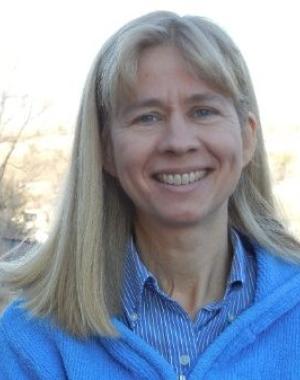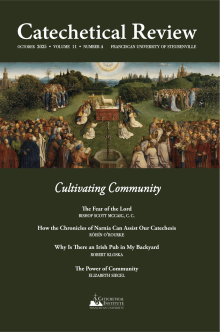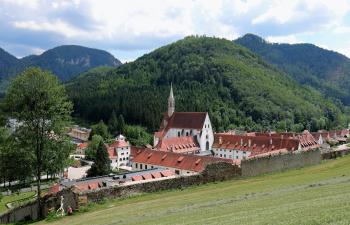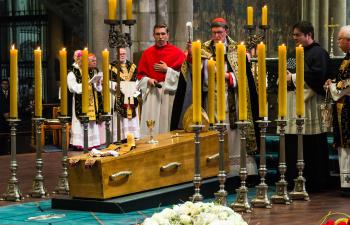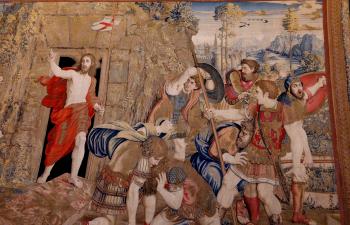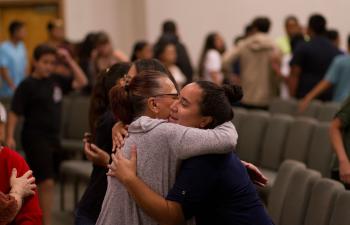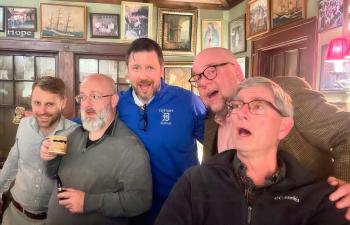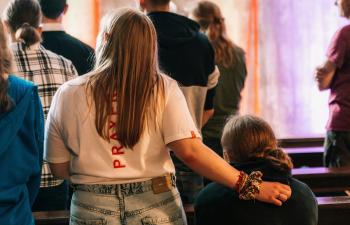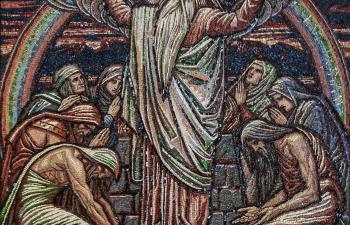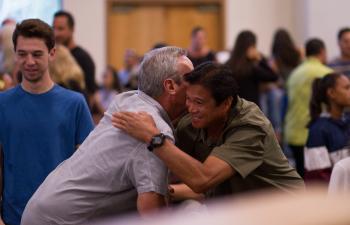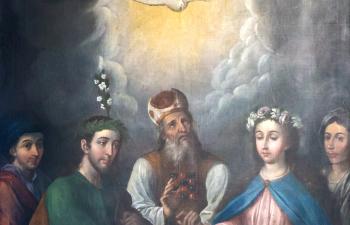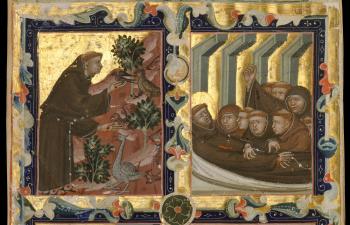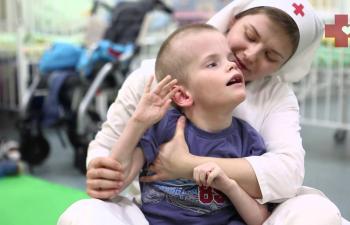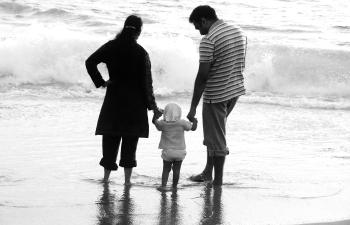 In the summer of 2002, I had a health crisis, and left a community where I had been discerning a vocation to consecrated life. Feeling alone, and at a loss as to how to move forward, I went home to my parents to recover. About a year later, my mother developed ALS, and after eight months in hospice care, went home to Jesus. I was still in poor health, without work, and grieving. I could not foresee how the Lord would come to my aid. Then my sister invited me to come to Michigan to help her homeschool her seven children, to a town and parish where, she claimed, the Catholic community was amazing. I had been in many places where I’d experienced rich community and was a little skeptical. But I felt deep peace and even certainty that this was the right next step—at least for a little while.
In the summer of 2002, I had a health crisis, and left a community where I had been discerning a vocation to consecrated life. Feeling alone, and at a loss as to how to move forward, I went home to my parents to recover. About a year later, my mother developed ALS, and after eight months in hospice care, went home to Jesus. I was still in poor health, without work, and grieving. I could not foresee how the Lord would come to my aid. Then my sister invited me to come to Michigan to help her homeschool her seven children, to a town and parish where, she claimed, the Catholic community was amazing. I had been in many places where I’d experienced rich community and was a little skeptical. But I felt deep peace and even certainty that this was the right next step—at least for a little while.
Six months after I arrived in my sister’s town, some new friends asked me how I liked being there. I answered: “I’d like to be buried here.” I was not being morbid. Rather, after spending several years in Europe, Washington DC, and Canada, I’d at last found a place to settle, to rest in, to belong.
As I cared for and instructed my three very young nieces and nephew, my soul began to come to life again and let go of grief. Through my sister and her friends, I found myself adopted into a vibrant group of Catholic families, most of whom homeschooled. The parents were serious about living their faith and forming their children in it. I looked forward to the weekly mom’s coffee and play group, and soon I was “Aunt Liz” to a host of children.
One day not long after I’d arrived in Michigan, I stayed to pray after daily Mass at the parish, and the grief over my recent losses surfaced. Crying, I was surprised to see a woman I did not know tap me on the shoulder, asking if she could pray with me. I said yes, and that was the beginning of a beautiful Christian friendship. It was also my introduction to a community where praying with others was a normal occurrence. In those early days, I took advantage of all kinds of opportunities for healing prayer, basking in the love and consolation I received.
Because there was no space for me in my sister’s house, I was invited to live with a family from the parish who lived down the street. They became fast friends. The father of the family enlisted my service on the evangelization committee at the parish. We promoted and facilitated new small groups, and soon I was meeting folks of all ages from all walks of life and welcoming them into the community of which I was still a new member.
The more people I met, the more I was amazed by the witness of faith. Funerals at the parish were powerful experiences of hope, and I left them inspired and eager to run the race well. One image in particular remains emblazoned in my memory. It was the memorial Mass for the adult son of a couple who had already lost their other son. During the opening hymn, the father stood in the front row of the church with his hands raised, praising God with full voice. Tears streamed down his cheeks, and yet, his faith in God’s goodness and mercy impelled him to give thanks even in the midst of heartache.
When Trials Came
Fourteen months after I moved near my sister’s family, I was unexpectedly diagnosed with colon cancer metastasized to the liver. In the two weeks in the hospital before and after surgery, so many people from my new Catholic community came to see me that the nurses grew concerned and put a sign on my door limiting visitors. There were even a few visitors I barely knew who, with great solicitude, had rushed to come to the hospital to make sure I was not going through this ordeal alone. In the year of chemotherapy that followed, I received meals, clean laundry, home visits, accompaniment at the chemo clinic, and an outpouring of prayers the like of which I had never known. My father, visiting me from out of state, was amazed by all of their kindnesses. A woman at the parish invited me to join a cancer support group she had formed. We shared stories and encouraged one another in faith. There, once again, I made friends who would be lifelong. Is it any wonder I was healed of stage IV colon cancer?
God knew precisely what I needed when I arrived in Michigan, and he knew what was in store for me with the discovery of cancer. He had plunged me into a community of believers, and I found there healing, deep friendships, shared life, the witness of faith, and a permanent home for my heart.
The Basis for Community
Fellowship (or community) is not accidental to the Catholic life. We hear in the Acts of the Apostles that the very first disciples after Pentecost gathered together for instruction, to pray, to share in the breaking of the Bread, and to fellowship (literally, have communion) with one another, making sure that each had what he/she needed (Acts 2:42–47). One of the significant developments in ecclesiology in the 20th century is the deeper understanding of the Church as communion.[1] In her being a communion, the Church reflects the very nature of the Trinity, an infinite communion of life and love among the Father, Son and Holy Spirit.
What is this communion, practically? When we are baptized, we are incorporated into the very Body of Christ and gain a whole set of relationships, some of which may be latent this side of heaven, but which are real and have incredible potential to come to life. Through our being implanted in the very person of Christ, we are “cheek n’ jowl” with others coming alive in faith. God’s plan is not just for us to be in him but to be in him together with all his sons and daughters. We are saved not merely as individuals but as a people. And the Lord wants to make us a beautiful, captivating people, which is manifested to the world when we pursue the life of grace—a life of prayer, mission, and service, living our lives together, helping each other as we progress in the way Jesus taught us.
In the Old Testament, two primary predicates of God are steadfast (committed) love and truth/faithfulness (in Hebrew, hesed and emet). These should be the backbone of our relating. We need to take on lives of committed love for one another, in common parlance, to “be there” for one another. But how many Catholics experience such committed love in their parishes (or even in their lives as Christians)? In the parish, as in society at large, people are typically fragmented, isolated, and confused about their identity. Designed to be an authentic community, the parish today has often disintegrated into a collection of people who do the same thing on Sunday morning. How can this essential dimension of Christian life be restored in the parish? According to St. John Paul II, the parish must become “a community of communities.”[2] These groups should be “of a size that allows for true human relationships,” “where the faithful can communicate the Word of God and express it in service and love to one another.”[3]
Forming Community in the Parish
One way to translate John Paul II’s insight is through the formation of permanent small groups within the parish. In a small group, people have a chance to get to know one another, to share together the experience of a deeper encounter with Christ through reflection on Scripture, testimony, and prayer. When people come alive in their faith together, a special bond is created by the power of the Holy Spirit. This bond can become the committed love mentioned above, which, rooted in a fuller participation in the sacramental life, leads to that laying down of one’s life for one’s friends that is the most authentic imitation of Christ’s own love. If we can uncover what God has for us in such committed relationships, we will know tremendous life and joy this side of heaven.
[1] See Second Vatican Council, Lumen Gentium, nos. 1 and 9; Gaudium et Spes, no. 24; CCC 760, 949–53.
[2] John Paul II, Ecclesia in America, no. 41.
[3] John Paul II, Ecclesia in America, no. 41; John Paul II, Christifideles Laici, no. 26. Cf. John Paul II, Redemptoris Missio, no. 51.
Art Credit: Image by Erika Giraud, Unsplash.com.
This article originally appeared on pages 19 - 23 of the print edition.
This article is from The Catechetical Review (Online Edition ISSN 2379-6324) and may be copied for catechetical purposes only. It may not be reprinted in another published work without the permission of The Catechetical Review by contacting [email protected]


